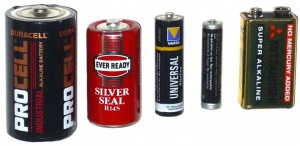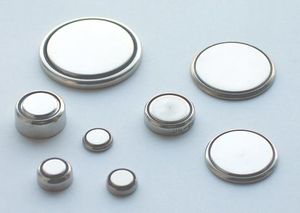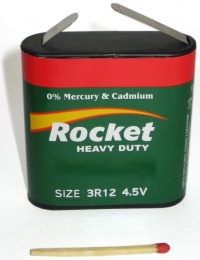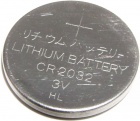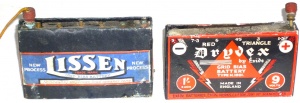Difference between revisions of "Battery"
(m cat) |
(→Battery capacity: batteryshowdown figures) |
||
| Line 163: | Line 163: | ||
PJ6 6v 26Ah | PJ6 6v 26Ah | ||
PP3 9v 0.6Ah 0.2Ah | PP3 9v 0.6Ah 0.2Ah | ||
| − | |||
Note that although alkaline cells have higher Ah ratings than nicads, they provide rather less capacity in high drain apps, and NiMH can give more time of use in these apps. [http://www.greenbatteries.com/batterymyths.html#lower capacity Ref] | Note that although alkaline cells have higher Ah ratings than nicads, they provide rather less capacity in high drain apps, and NiMH can give more time of use in these apps. [http://www.greenbatteries.com/batterymyths.html#lower capacity Ref] | ||
| + | [http://www.batteryshowdown.com/ Batteryshowdown] tested many brands of AA cell, with the following results: | ||
| + | * ZnC about 0.6Ah | ||
| + | * Alkaline about 2.1Ah | ||
| + | * Lithium 3-3.5Ah | ||
==Best before dates== | ==Best before dates== | ||
Revision as of 20:04, 20 September 2012
Terms
- Accumulator
- historic name for a rechargeable battery. More or less always refers to lead acid.
- Battery
- A battery means a quantity of cells used together. These may be housed in one container, such as with 6v and 9v consumer batteries, or they may be separate containers only electrically connected, as is common with large lead acid installations.
- Capacity
- Total output ability measured in amphours, current x time.
- Cell
- a single electrochemical unit producing electricity, usually from 1.2v to 3v (commonly 1.5v).
- C/20 etc
- charge rate. C/20 means capacity divided by 20, C/10 means capacity divided by 10 etc. Eg C/10 charge rate for a 1Ah battery would be 100mA.
- Cycle
- one charge & discharge
- Deep discharge battery
- lead acid battery optimised for deep discharge applications
- Drain
- taking power from the cell
- Dry cell
- Historic term for zinc carbon cells. Today there are also other dry types, so usage of the term sometimes refers to these as well.
- Electrolyte
- the liquid, gel or paste in the cell
- Energy density
- amount of energy stored per weight
- Float charge
- low current charge to keep battery topped up. See trickle charge
- Leakage
- Emission of liquid content from the cell. Zinc carbon and zinc chloride are prone to this. Leaked electrolyte is corrosive.
- Primary cell
- non-rechargeable cell
- Secondary cell
- rechargeable cell
- SLA
- Sealed lead acid.
- Starting battery
- lead acid battery optimised for engine starting, eg car battery
- Trickle charge
- very slow (low current) charge. See float charge
Battery chemistries
- Zinc carbon
- low cost, can leak.
- Zinc chloride
- improved performance version of zinc carbon
- Alkaline
- greater capacity than zinc carbon. However high drain apps dramatically reduce the capacity they can deliver.
- Not prone to leakage
- Longer shelf life than ZnC
- Ideal for low to medium drain apps, where they can give much longer service life than ZnC.
- Lithium
- long service life of upto 10 years if drain very low. Capacity and price are much higher than alkalines. 3v per cell.
- Lead acid
- Rechargeable, typically heavy high capacity batteries.
- Sealed lead acid (SLA)
- Spillproof lead acids.
- NiCd (nickel cadmium)
- Popular rechargeables, small light low capacity
- NiMH (nickel metal hydride)
- As nicad, but higher capacity & cost, and require NiMH chargers
- Silver oxide
- Coin cells, 1.4v per cell
- Li-ion (lithium ion)
- Most expensive type of rechargeable with high energy density. Used in laptops and very few cordless tools.
Coin cells
Widely used in PCs, watches, and miniature battery appliances. The smaller ones are also known as button cells.
With tiny capacity and max load current, these cells are only suited to micropower uses.
Chemistries
3 types of chemistry are popular in coin cells:
- alkaline - 1.5v per cell, lowest cost
- silver oxide - 1.4v per cell
- lithium - 3v per cell, highest cost
Common sizes
There are a large number of sizes still in production. A small range are much more popular than the rest, and are listed here. If you don't know what battery is needed, these are the first to look at.
Nearly all these battery sizes have various other names as well.
Most popular
- AAA 1.5v
- AA 1.5v aka penlight
- C 1.5v
- D 1.5v
- PP3 9v
- PJ6 6v - spring top lantern battery
1960s & 70s appliances
- PP9 9v
- other PP sizes are occasionally seen, eg PP6, PP7, PP10, PP11
- ? - 3v one somewhat like 2x C cells end to end
- 3R12, 3396 4.5v, strip terminals, mainly used in torches (pictured)
Cordless tools
sub-C Nicad 1.3Ah - 2Ah
Computers
CR2032 (3v lithium) is the most common BIOS battery in desktops. These retain BIOS settings when mains is unplugged.
Cars
12v 30-60Ah lead acid battery, either round or flat posts.
Cameras
- AA 1.5v
- 123 3v
- CR2 3v
Burglar alarms, UPSes
Sealed lead acid, 6v or 12v, various capacities
Multimeters
- AA 1.5v
- PP3 9v
- N 1.5v info
Battery capacity
These are typical figures only, in real life capacity varies according to brand and use conditions. Ref
alkaline nicad N 1.5v 1Ah AAA 1.5v 1.2Ah AA 1.5v 2.8Ah 0.7Ah C 1.5v 8Ah 2 Ah D 1.5v 20Ah PJ6 6v 26Ah PP3 9v 0.6Ah 0.2Ah
Note that although alkaline cells have higher Ah ratings than nicads, they provide rather less capacity in high drain apps, and NiMH can give more time of use in these apps. capacity Ref
Batteryshowdown tested many brands of AA cell, with the following results:
- ZnC about 0.6Ah
- Alkaline about 2.1Ah
- Lithium 3-3.5Ah
Best before dates
Best before dates are manufacturer recommendations intended to ensure batteries reliably do their job. Just like food best before dates, many are still fine long after this date, but not all.
In 2008 a bag of batteries was found containing a zinc chloride 9v stamped BB 1993 - and surprisingly it was good as new. 3/4 of the 1999 ones were also usable, a couple had corroded through.
Right: best before the 1940s
Refs
http://data.energizer.com/QuickSearch_Action.aspx?group=1&name=Energizer%20Alkaline
